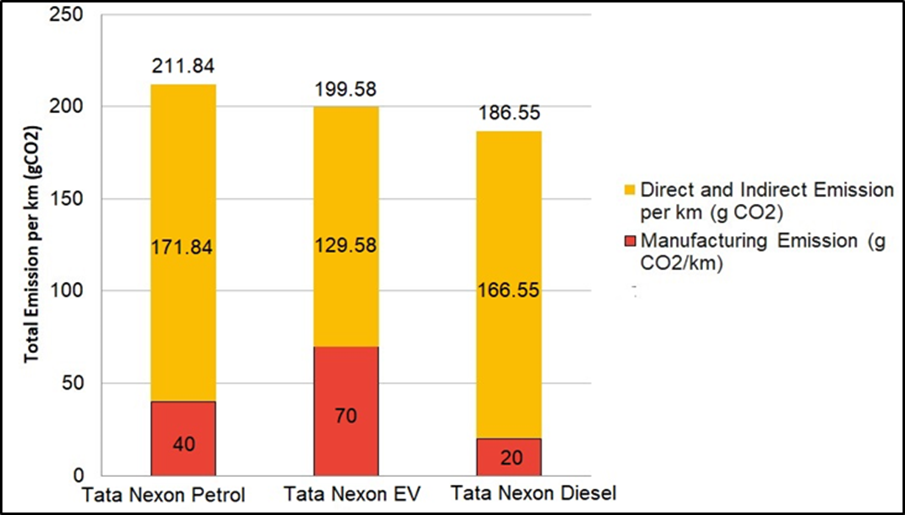Recently the Delhi government shared that in 15 months since it implemented a policy to promote electric vehicles (EVs), Delhi boasts 9 per cent EVs in comparison to the national average of 1.6 per cent.
9 per cent EVs in comparison to the national average of 1.6 per cent. This remarkable growth in EV sales, coming amidst a wider international shift towards EVs, has prompted a reassessment of the real time environmental benefits of widespread EV adoption across the world.
At the crux of this question is the manner in which vehicular emissions are calculated. Most emissions are based on tank-to-wheel energy use which omits emissions produced during the process of vehicle and fuel manufacturing (ITF 2021). These emissions are known as well-to-tank emissions, and along with tank-to-wheel emissions, provide a more comprehensive assessment of emissions produced by a vehicle in its life cycle.
EVs have low tank-to-wheel emissions since they forego the burning of fossil fuels in their engines. However, emissions produced in generating electricity to charge EV batteries are quite high since India’s power mix is still largely dependent on fossil fuels. In addition to this, the low mileage of EVs as compared to combustible fuel vehicles means their usage of electricity over a lifetime is also high, adding to the well-to-tank emissions. Furthermore, the transition to EVs would require a large-scale transport infrastructure system for charging and batteries, etc. which would be made mostly from steel and cement, materials that are currently produced from carbon-intensive industrial processes.

The data above compares the total emissions of the same model of a vehicle of different fuel types. Contrary to popular belief, EVs emit more total CO2/km than diesel vehicles, and barely less than petrol. The reason is that while the tank-to-wheel emissions of EVs are lesser than petrol and diesel vehicles, their well-to-tank emissions are much greater than both - almost double that of petrol, and more than triple that of diesel vehicles.
Making EV Adoption Greener
Data suggests that transitioning to EVs alone is not enough. A key component in making EVs greener is adopting cleaner energy sources for electricity generation. According to the International Energy Agency, as of 2020 44 per cent of India’s energy demand is met by coal, 25 per cent from oil and 6 per cent from natural gas (IEA 2021). India currently produces 155 GW of its power demand from non-fossil fuel sources and has made ambitious commitments to raise this to 500 GW by 2030. This would help India meet 50 per cent of the nation’s energy requirement from renewable sources and reduce total carbon emissions by 1 billion tonnes between now and 2030. India will become carbon-neutral and have net zero emissions by 2070 and reduce the carbon intensity of the economy to 45 per cent by 2030. These clean energy targets will make EV adoption a lot cleaner and more sustainable in the long term.
In order to ease automobile GHG emissions, the Delhi government is retaining the existing provision (Delhi EV Policy 2020) for the phased purchase of electric buses, accounting for at least 50 per cent of the new fleet. This will be accompanied by the active scrappage of old internal-combustion buses. Auto rickshaws are the second most used public transport medium, and although several rickshaws now operate on Compressed Natural Gas (CNG), a parallel movement to increase the number of electric autos is supporting the state's venture into a greener Delhi. In order to realise this goal, the state will provide financial incentives to increase demand-side appeal. Following this, the state is closely watching the pivotal pending judgment on the one-person one-permit provision of the existing policy. An analysis of the ground situation reveals that the rickshaw economy operates with one individual who owns a fleet of rickshaws and rents it out to the drivers. In such a case, a need assessment survey among the drivers will help negotiate the permit cap.
As India prepares to move towards a cleaner vehicular infrastructure, governments are acquiring a holistic understanding of the EV ecosystem, including its current challenges. This will help India create a better roadmap for expanding and improving EV infrastructure while ensuring that well thought-out EV adoption eases our collective emissions burden.
This article is co-authored by Aarushi Aggarwal and Kaustubh Mishra.


